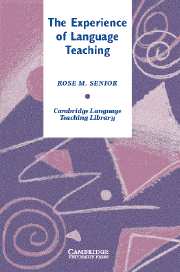Book contents
- Frontmatter
- Contents
- List of figures
- Acknowledgements
- Preface
- Introduction
- 1 Establishing a framework for the book
- 2 Training to be a language teacher
- 3 Becoming a committed language teacher
- 4 Establishing the learning environment
- 5 The diversity of the language classroom
- 6 Managing individuals
- 7 Teaching flexibly
- 8 Vitalising the language class
- 9 Maintaining the classroom community
- 10 Frustrations and rewards
- 11 What drives language teachers
- 12 Towards a teacher-generated theory of classroom practice
- References
- Index
12 - Towards a teacher-generated theory of classroom practice
Published online by Cambridge University Press: 05 November 2012
- Frontmatter
- Contents
- List of figures
- Acknowledgements
- Preface
- Introduction
- 1 Establishing a framework for the book
- 2 Training to be a language teacher
- 3 Becoming a committed language teacher
- 4 Establishing the learning environment
- 5 The diversity of the language classroom
- 6 Managing individuals
- 7 Teaching flexibly
- 8 Vitalising the language class
- 9 Maintaining the classroom community
- 10 Frustrations and rewards
- 11 What drives language teachers
- 12 Towards a teacher-generated theory of classroom practice
- References
- Index
Summary
The previous chapter described the assumptions, beliefs and values that underpin the classroom practices of language teachers teaching within the communicative tradition in western educational settings. It showed that, although they embrace the basic tenets of the communicative approach, experienced language teachers rarely follow ‘pure’ versions of the approach. Rather, they develop personal, hybridised versions of CLT – teaching in pragmatic ways according to their personal beliefs (developed from experience) about how best to teach language in classroom situations. The chapter also demonstrated that language teachers universally value classes that function in a cohesive manner, and are driven by a desire to develop and maintain rapport both with individuals and with their class groups.
The present chapter draws together the threads of the previous chapters, showing how the classroom experiences of practising teachers may be integrated into a teacher-generated theory of classroom practice. It is divided into two sections: Section 12.1 shows that the on-the-spot decisions of experienced language teachers are guided by a desire to keep their language classes in a state of harmony and balance. A biological metaphor is used to encapsulate the notion of teachers constantly adjusting their behaviour in line with the ongoing feedback they receive. Section 12.2 presents the central thesis of the book: that the classroom behaviour of language teachers is both pedagogically and socially driven. A second biological metaphor is used to represent the notion that pedagogic and social processes in language classrooms are intertwined and inextricably linked. A socio-pedagogic theory of classroom practice is then formulated.
- Type
- Chapter
- Information
- The Experience of Language Teaching , pp. 270 - 287Publisher: Cambridge University PressPrint publication year: 2006



